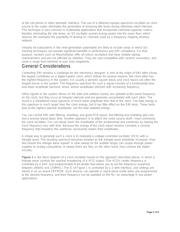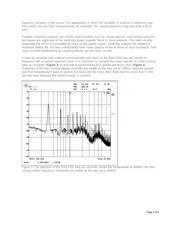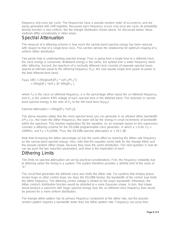herunterladen

Attend this brief webcast by Maxim on
TechOnline
Maxim > Design Support > Technical Documents > Application Notes > Audio Circuits > APP 3512
Maxim > Design Support > Technical Documents > Application Notes > Automotive > APP 3512
Maxim > Design Support > Technical Documents > Application Notes > General Engineering Topics > APP 3512
Keywords: EMI, noise, Oscillator, Spread Spectrum, Electromagnetic Interference, Radiated, overtone,
harmonic, app note 3512
APPLICATION NOTE 3512
Automotive Applications for Silicon Spread-
Spectrum Oscillators
Jun 08, 2005
Abstract: Digital-electronics systems enrich our lives in many ways, but digital clock signals also act as a
source of conducted noise (via cables) and radiated electromagnetic interference (EMI). Because the
potential noise problems are substantial, all of today's electronic products are tested to ensure
compliance with recognized EMI standards. But it's not just about EMI compliance. . . The use of spread-
spectrum (SS) oscillators is increasingly attractive for use in automobiles, where the benefits are seen
not just by instruments, but also by the driver and passengers—in clean performance of the electronic
automotive subsystems.
Automotive Advantages
Benefits of the SS approach go well beyond its efficacy in meeting
certain FCC and regulatory requirements for EMI compliance. The
benefits perceived for EMI compliance depend mostly on the
bandpass specification of your measurement technique. SS
techniques do minimize concentrations of peak energy, and the
resulting distribution of this energy into the noise floor does reduce
the need for filtering and shielding, but they can provide other
benefits as well.
The increasing number of high-performance multimedia, audio, video, and wireless systems deployed in
today's automobiles compels designers to pay special attention to any unwanted RF energy present at
frequencies to which these subsystems are sensitive. For high-quality radios and wireless data systems,
the elimination of RF energy peaks can determine whether a system is usable or not.
For years, radios have utilized a method known as frequency parking to avoid interference from power-
supply switching noise. Such radios actually communicate with the power supply, commanding it to alter
its switching frequency as necessary to shift energy peaks out of the tuner's input band. With the
increasing number of interference sources in a modern automobile, however, you cannot always
anticipate how the systems will work together. The situation is further complicated by the use of antenna
diversity systems, and by restrictions on the placement of new subsystems.
Other benefits of the SS oscillator can be found in digital audio and in the factory-installed, hands-free
interface. These systems commonly use a codec to increase audio quality by providing a digital interface
Page 1 of 8








